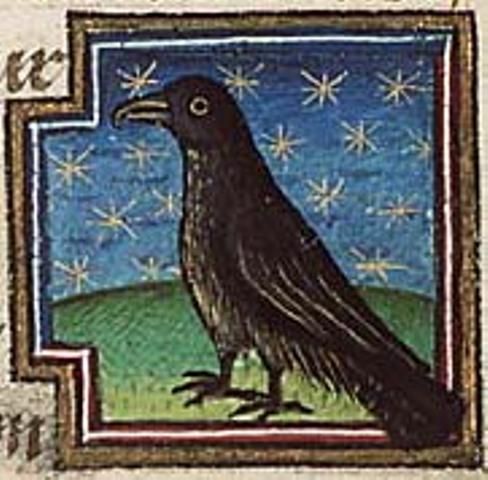















Wild Hunt The theme of the Wild Hunt is a common one in Europe and America; it combines elements both pagan and Christian, with certain motifs recurrent, such as the Hell Hounds.
The Wild Hunt is led by a psychopomp--the leader of souls to the Underworld. On certain nights--holy days--one could see the Hunter come for his prey. That the myth exists in Norther European cultures and their American descendents, as opposed to the Mediterranean and Middle Eastern cultures, is not surprising, for while the North certainly had agriculture, they also survived by hunting, particularly in the winter, when most of the legends of the hunt take place; often the hunt is held on the eve of Yule, though sometimes Samhain or Mother Night, and in Wales it may be associated with May Eve.
The Wild Hunt and he who leads it are known by many names:
The appearance of the hunt is usually uniform:
"A great noise of barking and shouting is heard; then a black rider on a black, white, or gray horse, storming through the air with his hounds, followed by a host of strange spirits, is seen. The rider is sometimes headless. Sometimes, particularly in Upper Germany, the spirits show signs of battle-wounds or death by other forms of mischance. Fire spurts from the hooves and eyes of the beasts in the procession. The horses and hounds may be two- or three-legged. Often the newly dead can be recognized in the train. The furious host is always a peril to the human being who comes into its way, though sometimes it leaves rewards as well." --Kveldulf Hagen Gundarsson, from Mountain Thunder, Issue 7, Winter 1992.
In English legend, the hunt is lead by Herne the Hunter; the history of Herne is that he was supposedly the game warden of Windsor Forest under Edward II; he saved the king from being gored by a stag, and died in the attack. He was revived by a local wonderworker, and the antlers magically attached to his head. In some stories, he looses his skills as a hunter to the wonderworker, hangs himself from an oak tree (the famous Herne's Oak), and is doomed to spend eternity riding for revenge on his death. The antlers and his name, of course, recount the Celtic god Cernunnos, but the exact connection is hazy.
In the Anglo-Saxon Chronicles, it appears in 1127:
"...it was seen and heard by many men: many hunters riding. The hunters were black, and great and loathy, and their hounds all black, and wide-eyed and loathy, and they rode on black horses and black he-goats. This was seen in the very deer park in the town of Peterborough, and in all the woods from the same town to Stamford; and the monks heard the horn blowing that they blew that night. Truthful men who kept watch at night said that it seemed to them that there might be about twenty or thirty horn blowers. This was seen and heard...all through Lenten tide until Easter."
In Walter Map's version (12th century), the hunter is King Herla (a fictitious king), a Saxon king who had made a pact with a fairy king, having eternal youth until he left the fairy mounds. Upon leaving the mounds, he was unable to descend from his horse, lest he grow old. He was also unable to return to the fairy mounds. Thus, he and his men are doomed to wander in this limbo for eternity, a story which has parallels in the stories of Oisin and Bran mac Febral.
And there are other, similar figures to those above: Wild Edric, Black Vaughan, Callow of Feckenham, Sir Peter Corbet, Harry-ca-Nab, Old Mother Darky (a woman, which is unusual), Grim, Abonde, Diana, Fraw Selga, Gulfora, and Satan all appear as the leaders of the hunt.
In America, there are a few possible continuations of the Wild Hunt; the first is Washington Irving's story "The Legend of Sleepy Hollow" with its Headless Horseman, whose appearance portends death. Like other foolish figures, Icabod Crane ignores the warnings of his neighbors and encounters the Headless Horseman and is never seen again (of course, in Irving's tale, it is implied that he just ran off to another town). Then there is the country song "Ghost Riders in the Sky", which sets the story in the Wild West. Finally, there is the story of Robert Johnson's "Hellhound On My Trail", which is thought to allude to the story of the songwriter selling his soul to the devil in order to become a great guitarist. That the singer must keep running from the hellhounds echoes the themes of the Wild Hunt. This was also put to use in the Coen Bros. film O Brother, Where Art Thou?, wherein the heroes are constantly trying to outrun bounty hunters who are, in fact, the devil and his posse coming for the escaped convicts, complete with hellhounds.

Back to "W" | Back to JCE
Home
Mary Jones © 2003